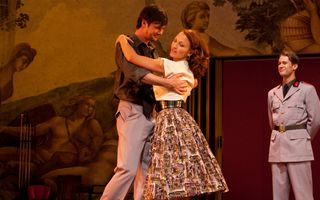MASKS & DECEPTION
The theme of deception is one which runs through the play. Shakespeare contrasts the moments where it is considered ‘acceptable’ with those where deception is a function of villainy.
The Masquerade ball provides a wonderful opportunity for the ‘unguarded comments’ that Beatrice makes about Benedick, perhaps not knowing who she dances with. This is certainly what he believes at any rate, and Benedick is clearly disturbed and hurt by Beatrice’s assessment of him. Don Pedro also uses his mask to talk to Hero without her realising his true identity. Don John takes advantage of the confusion caused by the masks to cause trouble by making false accusations.
Margaret and Borachio’s storyline is a very literal example of disguise. Margaret is convinced to impersonate her mistress, Hero, in a compromising situation. This trick is the pivotal point in the play: it leads to Hero being slandered, the wedding being ruined, and Benedick’s challenge of Claudio.
The matchmaking of Benedick and Beatrice is entirely built on deception, despite the couple having some underlying affection for one another. Shakespeare puts this deception alongside the more nefarious lies of Don John, asking his audience to interrogate in what circumstances the end justifies the means when it comes to dishonesty and trickery.
Beatrice and Benedick wear figurative masks through the play in the form of their witty exteriors. Benedick’s rhetoric could be masking a fear of marriage, or even a fear of dying alone. He jokes constantly about not being trapped in marriage and how married men will be cuckolded (cheated on by their wives). Beatrice also perhaps fears both marriage and single life – either being made subservient to a husband or, on the other hand, missing out on a relationship. Although both swear off marriage, they are only too eager once the opportunity arises.
Finally, there is the device of a revelation of a masked, virginal Hero at the end of the play. This device is used even more effectively in The Winter’s Tale, where Hermoine’s statue comes to life: a reincarnation of a woman also falsely accused and now vindicated. However, unlike Hermione’s husband Leontes, Claudio never admits his culpability in her fall from grace (he sees himself as wronged as well), which takes away the power of the moment in this play.
DIFFERENT KINDS OF LOVE
In the play Shakespeare contrasts ‘courtly’ love, characterised by fine sentiments, sincerity and the formal process of wooing, courtship and marriage, with combative love, characterised by battles of wits, irony, and cynicism about marriage. Hero and Claudio fit in to the former category and Beatrice and Benedick into the latter.
Within the world of the play there is no judgement expressed about the relative strength or value of one kind of love over another, and certainly Shakespeare draws no conclusions. However, arguably a modern audience feels more faith in Beatrice and Bendick. There is a hint of a rocky history between the two and indeed their courtship is built on gossip and deception, but we undoubtedly assign a certain value to the kind of ‘warts and all’ approach of Beatrice and Benedick, and are sceptical about the seemingly face-value love between Hero and Claudio.
GENDER POLITICS
It has been said that while Much Ado About Nothing plays with gender stereotypes, the play ultimately reinforces a patriarchal, hierarchical world view. Beatrice and Benedick, who rail against marriage, ultimately get married. The marriage of Hero and Claudio proceeds, once Hero’s honour has been re-established.
Beatrice seems to step outside the traditional ‘feminine’ role, which Hero adopts unquestioningly. However, even Beatrice’s berating of Benedick tacitly accepts gender relationships as they existed in her society: Beatrice says “O that I were a man!” (Act 4, Scene 1), before urging Benedick to challenge Claudio. The fact that she is a woman, denies her agency within her world and the story.
Overall, in Benedick and Beatrice, Shakespeare has given us a very modern couple – a feisty and evenly matched relationship, which will probably continue in this vein after the play’s conclusion. It’s as if Shakespeare gives us a conventional relationship, and then another one which strains the bounds of conventionality, without breaking either of them





